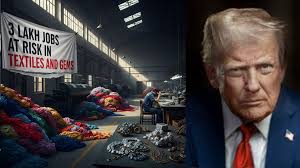Recent US tariffs on Indian exports have raised concerns across various sectors, particularly in textiles and gems, with estimates indicating that as many as 300,000 jobs could be at risk if these restrictions continue. While some experts emphasize the significant job threats, others contend that India’s strong domestic demand and trade diversification may lessen the impact. The sectors most at risk include textiles, auto components, and MSMEs, whereas industries such as pharmaceuticals seem to remain unaffected. Additionally, there are worries about potential ripple effects in IT services and Global Capability Centres, as hiring slows down amidst ongoing trade tensions. The recent US tariffs on Indian exports have generated apprehension across multiple industries, especially textiles and gems, with experts estimating that up to 2–3 lakh jobs could be endangered if the trade restrictions persist for an extended duration. While some staffing specialists predict a considerable impact, others maintain that India’s robust domestic demand and trade diversification could mitigate the adverse effects. According to R P Yadav, Founder & CMD of Genius HRTech, sectors such as textiles, auto components, agriculture, and gems & jewellery are among the most susceptible. Given their labor-intensive nature, textiles alone could potentially lose nearly 1 lakh jobs if tariffs remain in place for more than six months. Additionally, gems hubs like Surat and Mumbai’s SEEPZ are also at risk of significant employment disruptions due to declining demand and increasing costs in the US market. The ramifications of US tariffs on Indian employment remain uncertain. While experts like Yadav caution about immediate risks to nearly 3 lakh workers, others emphasize that India’s strong domestic economy and trade partnerships could offer some protection. Until trade negotiations advance, industries closely linked to US exports—particularly textiles and gems—are left in a state of anxious anticipation.





